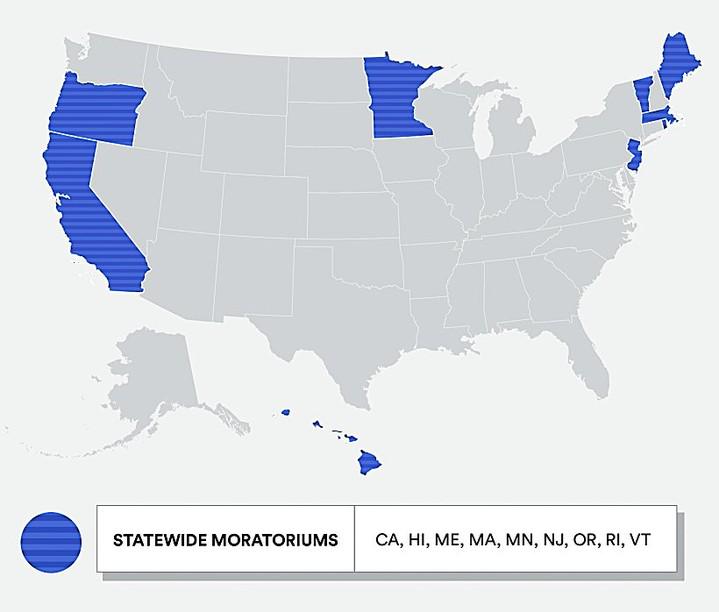Map of U.S. States with Nuclear Power Plant Bans


David Chen
Data Visualization Specialist
David Chen is an expert in transforming complex geographic datasets into compelling visual narratives. He combines his background in computer science ...
Geographic Analysis
What This Map Shows
This map visually represents the U.S. states that have enacted bans or restrictions on the construction of nuclear power plants. In an era where energy decisions are increasingly scrutinized, understanding where these bans exist can provide insights into the broader landscape of energy policy in the United States. The visualization highlights states that have actively chosen to limit or prohibit nuclear energy development, reflecting public sentiment, political stances, and environmental concerns surrounding nuclear power.
Deep Dive into Nuclear Power Plant Bans
Nuclear energy has been a contentious topic in the United States for decades. As a low-carbon energy source, it offers the potential to significantly reduce greenhouse gas emissions. However, concerns over safety, waste disposal, and the potential for catastrophic failure have led to public resistance and stringent regulations. Currently, 10 states have outright bans on the construction of new nuclear power plants, while others have implemented restrictive measures that effectively halt new developments.
Interestingly, the reasons behind these bans are as varied as the states themselves. Public perception plays a crucial role. Following incidents like the Fukushima disaster in Japan in 2011 and the Three Mile Island accident in 1979, many citizens have grown increasingly wary of nuclear energy. For instance, California, which has a long-standing ban on new nuclear plants, has seen vocal opposition from environmental groups and local communities. The state's focus on renewable energy sources like solar and wind reflects a broader trend towards diversifying energy portfolios.
Moreover, the economic landscape also factors into these bans. The high upfront costs and lengthy timelines associated with nuclear plant construction deter investment. States such as Vermont and New York have opted against nuclear development, partly due to the preference for cheaper alternatives like natural gas and renewables. In fact, New York's decision to close the Indian Point Energy Center, a key nuclear facility, was motivated by safety concerns and the desire to transition to cleaner energy sources.
Interestingly, some states have not only banned new nuclear plants but have also undertaken efforts to decommission existing ones. For example, the closure of the San Onofre Nuclear Generating Station in California illustrates the shift in energy strategy toward sustainability and safety. This growing trend raises questions about the future of nuclear energy in America. Will states continue to move away from nuclear power, or will advancements in technology and safety standards reignite interest?
Regional Analysis
When looking at the map, we can see geographical patterns emerge. The Northeastern states, such as Vermont and Massachusetts, are particularly restrictive regarding nuclear power. This is often attributed to historical accidents and a stronger emphasis on environmental policy in the region. In contrast, Southern states like Georgia and South Carolina have continued to pursue nuclear projects, indicating a more favorable view of nuclear energy's role in achieving energy independence and stability.
The Midwest presents a mixed picture. States like Illinois have significant nuclear infrastructure and are home to several operating plants, while others in the region have opted against new developments. This dichotomy reflects varying attitudes towards energy security and environmental responsibility. Interestingly, even in states with operational nuclear facilities, there can be strong local opposition to new plants, showcasing the complex interplay between local and state-level energy policies.
Significance and Impact
The implications of these bans on nuclear power plants are profound. As the U.S. seeks to transition to a carbon-neutral economy by 2050, the debate over nuclear energy’s role becomes increasingly critical. While nuclear power can provide a stable and substantial portion of the energy mix, public fears and economic considerations often overshadow its benefits. The map serves as a reminder of the significant challenges that lie ahead in reconciling energy needs with public safety and environmental stewardship.
In conclusion, the landscape of nuclear energy in the U.S. is evolving. With many states firmly against new nuclear plants, the focus is shifting toward renewable energy. However, as climate change poses more pressing challenges, will nuclear energy make a comeback? The future may hold new technologies and policies that could reshape this contentious debate, but for now, the map of bans reflects a cautious approach to one of the most powerful energy sources available.
Visualization Details
- Published
- August 13, 2025
- Views
- 242
Comments
Loading comments...